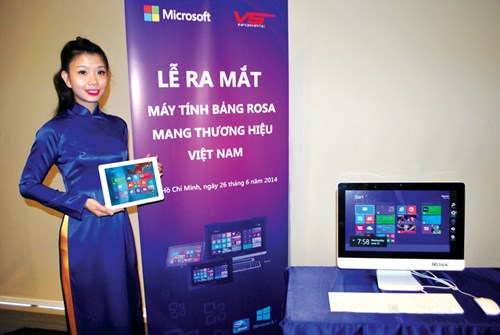As some local hi-tech products put on mothballs, others introduced
Update: 06-07-2014 | 00:00:00
Vietnamese technology firms are continuing tomake every effort to launch new products into the market, even though made-in-Vietnam productshave yet to receive a warm reception.

ROSA, a tablet model introduced by Viet Son Company, is advertised as a “made-in-Vietnam” product.
Two questions were on the attendants’ minds at the product launching ceremony for ROSA. First, is it truly a made-in-Vietnam product – that is, has it been both designed by Vietnamese and produced in Vietnam? Second, can the product survive in a market already saturated with low-cost tablets? Many other Vietnamese technology firms have tried to develop hi-tech products themselves. As of yet, none has succeeded. Hanel, a Hanoi-based electronics manufacturer, and CMS, a subsidiary of CMC Technology Group, also revealed plans to manufacture tablets for commercial purposes. However, after making announcements to the mass media, neither has made any move to implement its plan. Analysts commented that it is not difficult to produce tablets or smartphones, but it is not easy to sell them in Vietnam, where consumers all turn their backs on domestically made products. “By marketing ROSA, Viet Son might try to build up a Vietnamese brand and compete with Chinese imports by providing good post-sale service,” a market analyst said. He went on to say that Vietnamese technology firms are still hope they can find the right formula to allow them to conquer the domestic market. Vietnamese need to create added value rather than simply assembling parts and accessories imported from China. They also cannot take the risk of spending too much money to set up A-to-Z production lines, while they are not sure if they can succeed. A senior executive of CMS said that it would be better for Vietnamese companies to make investments only in those phases of the value chains which can generate the added value specifically suitable to Vietnamese users. Meanwhile, they can cooperate with partners to develop operating systems and applications. This is exactly the path FPT has been following in developing FPT-brand smartphone models with the Fstore content app store. The exec said Vietnamese technology groups should learn from the “smartphone lesson”. The years 2009 and 2010 witnessed a boom of Vietnamese-branded smartphones, from Q-Mobile and Bluefone to Mobell, MobiStar and F-Mobile. However, the low-cost models were ultimately dislodged from the home market by Chinese imports. “The time when Vietnamese firms can make money by importing Chinese products and labeling the products with their brands is over,” he commented. “Meanwhile, no one can say for sure if assembling imported parts and accessories in Vietnam, the way automobile manufacturers do, is the right approach for technology groups,” he added. Vietnamese manufacturers face big difficulties when taking that path. Viettel, known as one of the three biggest telecom groups, has to import 70 percent of the parts needed to assemble smartphones, and those imports bear high tax rates of 15-25 percent. By contrast, under international free trade agreements to which Vietnam is bound, smartphones imported as completely built units (CBU) are taxed at zero percent. VietNamNet Bridge- Rare Salamander discovered in central Vietnam (05/08)
- Nearly VND16bln disbursed to realize the local sci-tech task (31/07)
- Vung Tau - Hong Kong Internet connection resumes (30/07)
- 2014: the year of mobile games (28/07)
- US Senate body ratifies civilian nuke deal with Viet Nam (27/07)
- Vietnam rises in tech rankings (23/07)
- VN wastes funds on overseas training for nuclear energy workforce (14/07)
- Technology groups question Ministry’s hardware development strategy (12/07)



